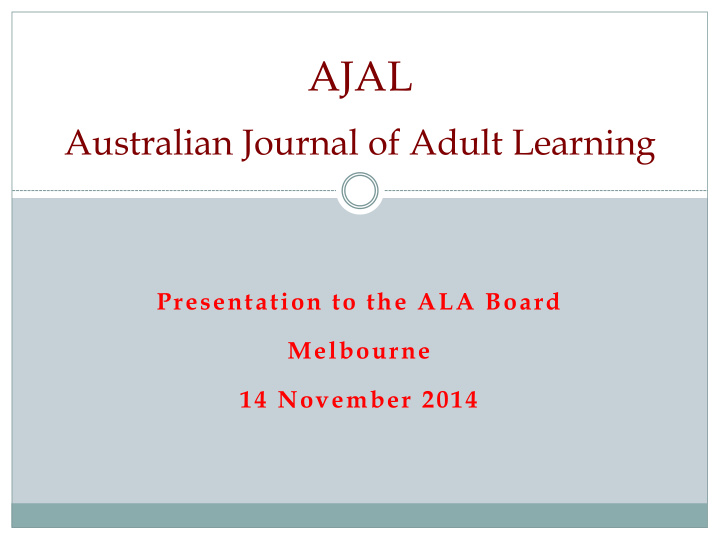



AJAL Australian Journal of Adult Learning Presentation to the ALA Board Melbourne 14 November 2014
Outline Current state of the Journal & its contributors Classifying content AJAL’s Status Changes in academic publishing ->Future
Some context 54 years. Reflecting the ‘field’ - AJAE; AJACE 2000 – AJAL became a ‘refereed’ journal (including both refereed & non-refereed) Akin to the publications of NIACE ( Studies in the Education of Adults ) and the US ALA ( Adult Education Quarterly ) Now essentially a refereed journal Different in purpose to other publications eg Quest.
General information 2012-15 The data here refers to the eight issues from 2013; 2014; and 2015 (first 2 issues which are not finalised yet) Note the November 2014 issue is due out this month and was a Special Issue on Lifelong Learning in the Asian Century
AJAL Contributions since 2013 8 Issues published (or in advanced state of preparation – 2013-2015) Articles Women Men Aust Oversea s 43 Refereed 61 26 71 16 7 Non-refereed 5 7 5 7 7 Invited reviews 3 4 7 - 4 Book Reviews 1 3 4 -
Acceptances & Rejections Since 2013 the Journal has received 103 submissions for refereeing and 7 non-refereed submissions. Of those 103 43 – accepted & published (or pre-press) 38 – rejected or withdrawn 7 – returned and waiting for re-submission 15 – under review or recent submissions This makes for a rejection rate of approximately 40%
Content & Topic Areas Reflects changing post-school education environment Higher Education – bridging/enabling/pathway programs; pedagogies; diverse student groups; Indigenous studies; online technology & e-learning; assessment; teacher PLCs theory eg transformative learning & practices Work based learning – VET in Community & Health services & professions; balancing study & work; research & HE pedagogy Rural – mature age women; civic engagement; leadership programs; higher education; lifestyle (tree)changes Literacy – workplace literacy; adults with development disabilities -> self advocacy History (2) – Syd Uni tutorial classes; Uni Newcastle pathway programs Community programs – personal development; against extremism Environment – green skills low carbon economy Asian century collection
Referees & AJAL Extending the pool. Deliberate effort to increase number of international reviewers & leaders in their field to strengthen quality and increase AJAL ‘exposure’ Reviewers from 12 countries used – Canada, Finland, Germany, Hong Kong, India, Malaysia, Montenegro, New Zealand, Singapore, South Africa, UK and USA Year No Women Men Aust O/seas Uni Non- Uni 2013 34 21 13 28 6 33 1 2014 55 33 22 36 19 50 5
Journal Status Where does AJAL sit? Ranking systems, and Databases ERA (Excellence in Research for Australia) 2010-2012 Other measures include: Impact Factor (a measure of the mean number of citations in all other Journals over a given period). See Thompson’s Web of Science Scopus Journal Rankings (SJR). Includes ‘impact factor’ plus other metrics. Rejection rates (more rejections = higher quality ??) AJAL ranks highly on ERA, but less so on WoS and SJR
ERA Journal Rankings (2010) – [Excellence in Research for Australia] 5% - All articles ‘top quality’ A* – World’s Best A 15% - majority of articles ‘top quality’ (AJAL) B 30% - only a few expected to be top quality C 50% - d not meet the criteria of top tiers In Social Sciences & Humanities (SSH) >13,000 journals
Some challenges Dilemma of broad approach reflecting ‘adult’ learning & lifewide – lifelong while retaining a focused journal space for communication, practice and exchange Too ‘catholic’ ? Not focused enough? Some misunderstanding of the Journal judging by ill-considered submissions Practical challenges – operating an old-style system in a changing era eg very hands on, not computerised & not managed by large publishing houses (eg IJTR (AVETRA) -> Taylor and Francis from 1 January 2015. Others offering quick online publication for a fee
Recommend
More recommend